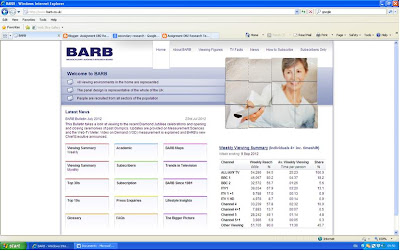BARB is a website that tells how many people watch certain programmes. The BARB website carries viewing data within the Viewing Figures section; TV Facts provides you with various facts such as Multi-Channel Development since 1992; BARB since 1981 lists the 10 most watched programmes for each year and 30 most watched programmes for each year. This is an example of options you can choose to find out more.
This is an example Top 30 programmes.
RAJAR stands for Radio Joint Audience Research and is the official body in charge of measuring radio audiences in the UK. It is jointly owned by the BBC and the Radio Centre on behalf of the commercial sector. This is an example of what the website looks like.
This is an example of listening figures in UK.
NRS stands for National Readership Survey and provides the most authoritative and valued audience research in use for print advertising trading in the UK. The survey covers over 250 of Britain's major newspapers and magazines, showing the size and nature of the audiences they achieve.
Advantages of secondary research. First advantage is inexpensive, Secondary research can be virtually free for a wide variety of topics through the use of the Internet or going through public records or libraries. Data is available freely or at far lesser cost through secondary sources.
Second advantage is easy to access, the Internet has made huge amounts of information on a wide variety of topics readily available at your fingertips. Internet search can pinpoint the information you are looking for.
Disadvantages of secondary research. First disadvantage is secondary data may have been collected some time ago and, therefore, be out-of-date. Because it has been collected for another purpose, it may be in the wrong format or incomplete.
Second disadvantage is that secondary analysis can be used in irresponsible ways. If variables aren't exactly those you want, data can be manipulated and transformed in a way that might lessen the validity of the original research.





No comments:
Post a Comment